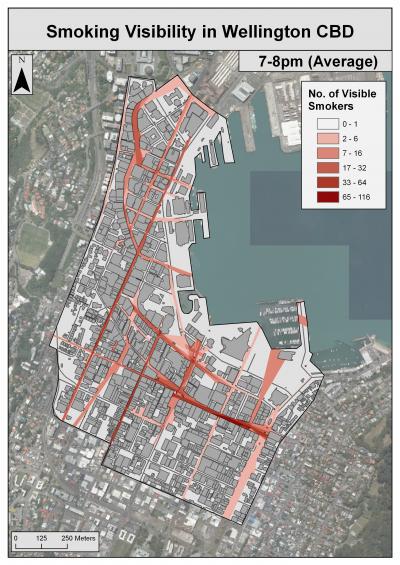Smoking visibility mapped for the first time

The visibility of smoking in city streets has for the first time anywhere been mapped, in new research from the University of Otago, Wellington, New Zealand. Data from observations across the downtown area were mapped by the researchers, producing a record of the street areas where the most smokers could be seen. They used mapping methods previously used for landscape ecology and archeology.
Credit: University of Otago, Wellington
Smoking visibility mapped for the first time
The visibility of smoking in city streets has for the first time anywhere been mapped, in new research from the University of Otago, Wellington, New Zealand.
The research found that up to 116 smokers outside bars/cafés could be seen from any one location in the outdoor public areas of downtown Wellington (e.g. on a footpath). Of 2600 people observed in the outdoor areas of bars and cafés, 16% were smoking, with a higher proportion than this in evenings.
Data from observations across the downtown area were mapped by the researchers, producing a record of the street areas where the most smokers could be seen. They used mapping methods previously used for landscape ecology and archeology.
Lead researcher Dr Amber Pearson says that the methods developed through this research will help policymakers demonstrate the visibility of smoking in different areas, and provide scientific evidence for local authorities to advance smokefree outdoor policies.
Another of the researchers, Associate Professor George Thomson, says the results show the need for policies to reduce the normality of smoking:
"Smokefree outdoor areas help smokers to quit, help those who have quit to stick with it, and reduce the normalisation of smoking for children and youth. They also reduce litter, water pollution and cleaning costs for local authorities and ratepayers," Thomson says.
In Australia, North America and other places, local authorities are increasingly creating smokefree streets and promoting smokefree al fresco dining and drinking, he says.
###
The study has been published in the international journal BMC Public Health and was funded by the Cancer Society of New Zealand (Wellington Branch).


 Science Media Centre: Cyclone Gabrielle's Impacts On NZ's Ecosystems - Expert Reaction
Science Media Centre: Cyclone Gabrielle's Impacts On NZ's Ecosystems - Expert Reaction RNZ: Parts Of Power System Could Be Out For 36 Hours In Event Of Extreme Solar Storm
RNZ: Parts Of Power System Could Be Out For 36 Hours In Event Of Extreme Solar Storm NZAS: New Zealand Association Of Scientists Awards Celebrate The Achievements Of Scientists And Our Science System
NZAS: New Zealand Association Of Scientists Awards Celebrate The Achievements Of Scientists And Our Science System Stats NZ: Retail Spending Flat In The September 2024 Quarter
Stats NZ: Retail Spending Flat In The September 2024 Quarter Antarctica New Zealand: International Team Launch Second Attempt To Drill Deep For Antarctic Climate Clues
Antarctica New Zealand: International Team Launch Second Attempt To Drill Deep For Antarctic Climate Clues Vegetables New Zealand: Asparagus Season In Full Flight: Get It While You Still Can
Vegetables New Zealand: Asparagus Season In Full Flight: Get It While You Still Can 



